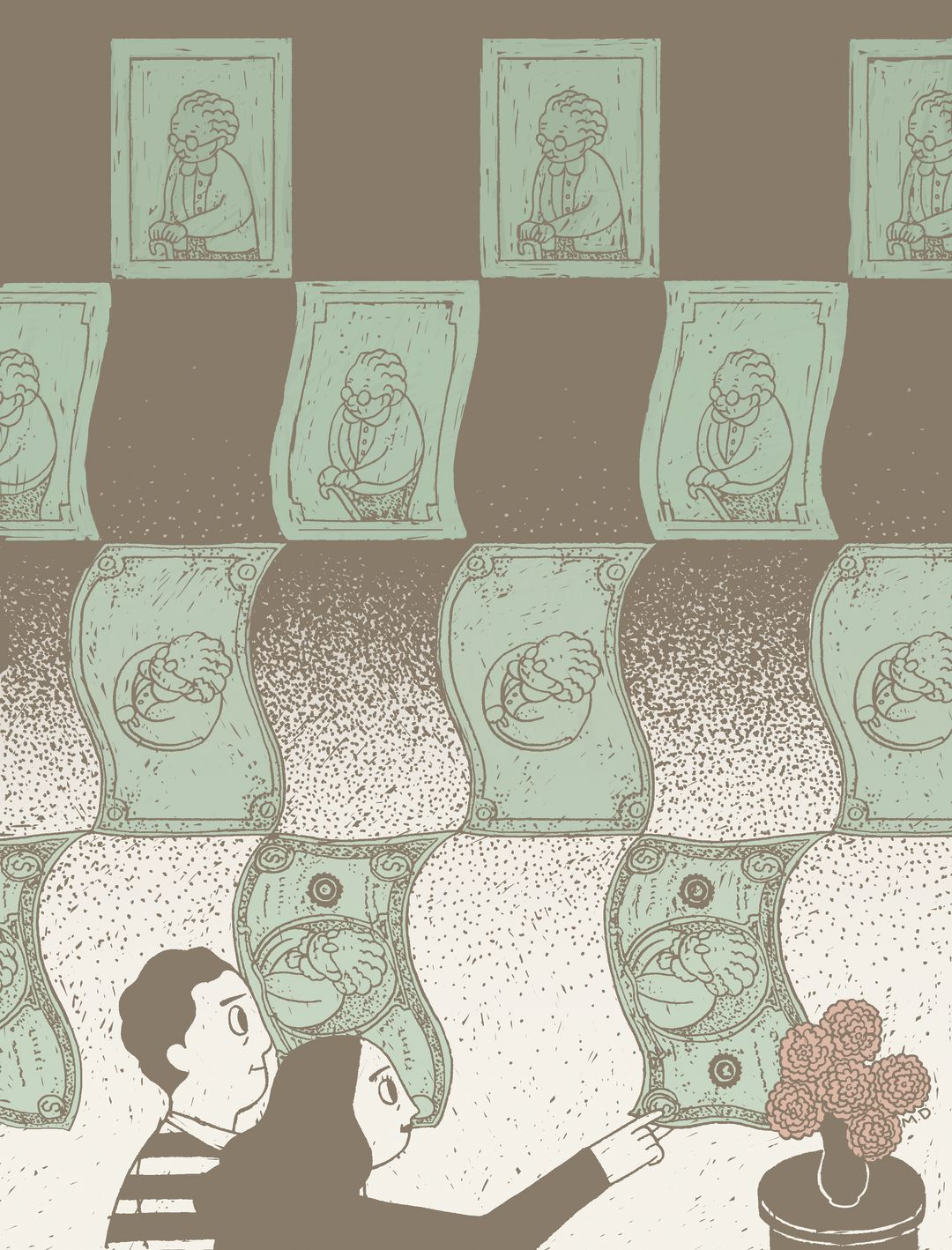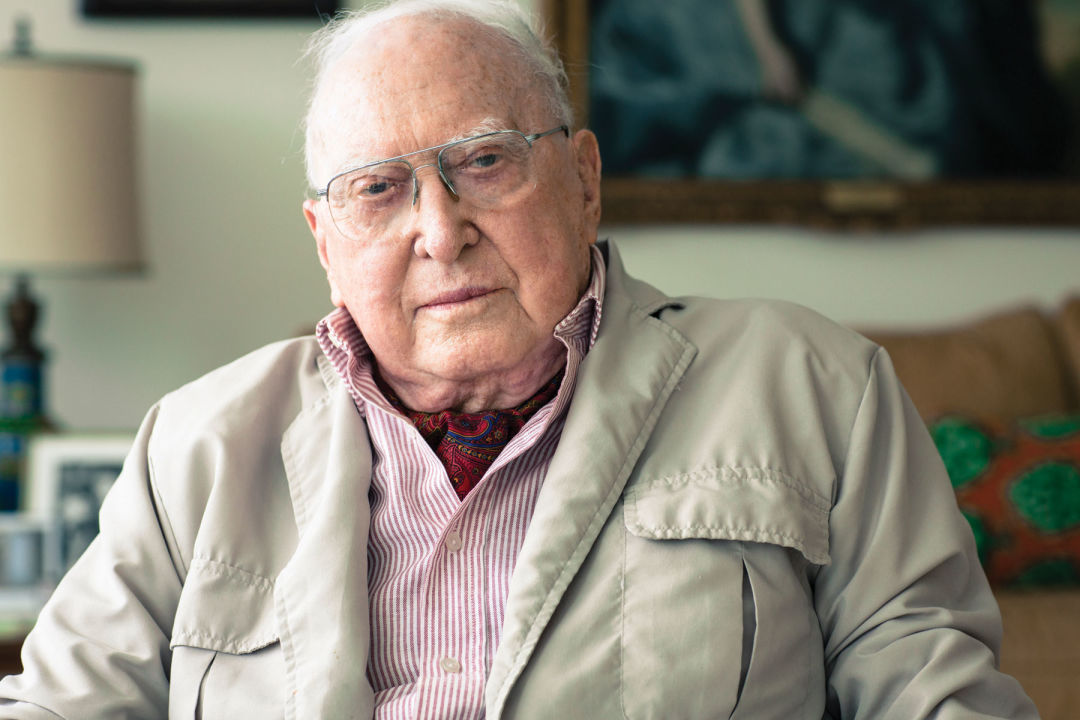Some Lucky Baby Boomers Will Become Very Rich, Very Soon

Image: Molly Dean
Nothing—well, almost nothing—is more titillating than money.
Want to tempt somebody to read an article (like, say, this one)? Then just drop a few names, preferably Gates, Buffett, Ellison, Zuckerberg or Bezos. Or maybe discuss the fascinating wealth scoreboard at Forbes.com, which tracks the minute-by-minute ups and downs of the richest Americans’ net worth. Oh, look, Nike stock tanked today, and Phil Knight lost $875 mil; he’s down to his last $25.4 billion. Let’s help the poor guy out by buying a pair of Air Jordan Super.Fly 4s.
With curiosity about money and the moneyed rampant in our society, it’s somewhat curious, then, that so little has been written recently about a potent tonic coursing through the nation’s economic bloodstream: a colossal and unequalled transfer of wealth that will continue for years as America’s oldest citizens pass into history and their cash, securities and property pass down to their descendants.
Millions? Billions? Peanuts. The amount that will change hands during this intergenerational shift, which began a few years ago and will continue into the 2050s or 2060s, could be as little as $30 trillion or as much as $190 trillion, depending on who is doing the estimating and what assumptions are made about the long-term growth of the economy and the level of estate taxes.
At the lowest end, these figures are impressive; at the highest, they’re staggering—bigger than the approximately $18 trillion in goods and services the entire U.S. economy churned out in 2015. Consider: If you spent $1 million every minute, it would take almost two years to dispose of just $1 trillion.
Whatever the total turns out to be, this inherited wealth will strongly affect the nation, and places like Sarasota likely will see a disproportionate slice of it.
The wellsprings of these riches are two population groups that have become mainstays of the obituary pages: the Greatest Generation, whose youngest members are now in their early 90s, and the often-ignored Silent Generation, whose survivors are 71 to 91 years old.
These groups experienced both hardship and an extraordinary bit of luck. Many of their members lived through the Great Depression and World War II. But when peace returned in 1945, some entered their working primes at a uniquely opportune moment for America.
The dollar had become the globe’s de facto currency for trade and financial transactions. The nation had lost fewer skilled workers and managers, relative to the size of its population, than any other major combatant. Its goods had a reputation for quality. And its huge industrial base was intact, and so could supply the rest of the world, while ravaged Europe and Asia needed years to rebuild or develop export capacities. The U.S. balance of payments—the value of goods and services exported, minus those imported—would stay positive for a quarter-century, until the spring of 1971. That’s quite a contrast with today.
All this created jobs, broadened the middle class and helped fuel a huge domestic consumer market. Home sales boomed. Americans purchased cars, washing machines, furniture, televisions. Most important, the U.S. had an optimism, born of military and moral triumph, that encouraged risk-taking and entrepreneurship. And many of those smart, tenacious and industrious enough to seize the moment squeezed fortune out of it, fortune now flowing to Baby Boomers, Gen-Xers and generations beyond.
In 1999, Paul Schervish and John Havens, researchers at Boston College, published a widely discussed study predicting the coming of the great intergenerational transfer of wealth. Both are retired now, but two years ago, they released an updated version and found that the newest numbers pointed to a shift 12 percent larger, in real terms, than their original work had predicted.
Speaking from his home in North Carolina, Schervish notes that the latest analysis offers several scenarios, based on assumptions that the U.S. economy will expand by anywhere from 1 percent to 4 percent annually, and that estate taxes will be at one of two levels.
In part, the study covers the 55 years from Jan. 1, 2007, through 2061. To ensure apple-to-apple comparisons, all forecasts are in 2007 dollars. The scenario that Schervish considers the most likely includes a 2 percent annual economic growth rate, leading to $59 trillion being transferred. Schervish notes that the Federal Reserve Board’s triennial Survey of Consumer Finances, the key to his calculations, doesn’t take into account the 400 people on Forbes annual list of the richest Americans. “But that wouldn’t change the numbers by more than a trillion,” he jokes.
What does change the 55-year total markedly is to boost the assumed economic growth rate to 4 percent, a figure that Schervish views as very unlikely. In that case, the wealth shift balloons to a mind-bending $188.5 trillion.
Schervish says that the latest study disclosed a surprising trend: “When we first started looking at the Fed’s survey, around 1989, we noticed that the very wealthy actually started to reaccumulate wealth around age 70. They already had their two or three houses, a yacht, whatever they wanted, and even if they were giving money to their heirs and to charities, they were actually getting richer from their investments and other sources. This has subsided. One reason is that the wealthy, like most of us, are living longer and so giving more money to charitable foundations in their lifetime. Second, they’ve increased the number of trusts, generation-skipping trusts, and family limited partnerships for their heirs. The upshot is that 17 percent of what previously would have gone to their estates at death is showing up earlier.”
Richard Hokenson, a longtime Wall Street economist who now works for U.S. investment firm Evercore Partners’ research unit in Holland, has a broad knowledge of demographics and wealth trends. Speaking from Amsterdam, he observes: “What’s brand new for us today is that, for the first time ever, because of greater longevity, we have multiple generations of retired households alive at the same time. We never had that before. In the past, when people retired, their parents were dead, and whatever money they would get had already been transferred.
“The question I always ask is: Who does the money go to? What seems to be happening is that more money is skipping generations. If it were to go to the children [of the people making bequests], it would mean that a lot would be spent on services and experiences—travel or whatever. But grandparents are increasingly paying the educational costs of their grandchildren and their great-grandchildren.” In addition, he says, more people are funding the payments their grandchildren or great-grandchildren use to buy a house.
While the wealth shift will affect most Americans, the immediate beneficiaries mainly are the baby boomers, now 52 to 70. That’s good news for the North Port-Sarasota-Bradenton federal metropolitan area, made up of Sarasota and Manatee counties. A hefty 30.4 percent of its residents are boomers—the highest percentage of any midsize metropolitan area in the U.S., according to Headlight Data, an online economic and demographic information outfit. And the area’s many attractions for retirees are likely to boost that percentage over the next few years.
However, most boomers won’t inherit enough to make a significant difference in their lives. A 2010 MetLife study predicted that the average amount would be $64,000. That’s because a relatively small number of households—those with at least $1 million in investable assets—are likely to account for the bulk of the major inheritances. That, of course, raises the possibility that the income and wealth gaps between the richest and poorest Americans will widen, with potentially dangerous consequences.
That gap already yawns in Sarasota, where much of the wealth is imported via retirees or second-home owners who have made their money elsewhere. According to Phoenix Marketing International’s PMI Global Wealth Monitor 2015 study, 20,281, or 6.1 percent, of the 330,471 households in the North Port-Sarasota-Bradenton federal statistical area have at least $1 million in assets. The U.S. average is 5.4 percent. Phoenix’s calculations don’t include the value of primary homes and company-sponsored retirement accounts, such as 401(k)s; if they did, the local and national figures would certainly be much higher.
At the same time, the estimated number of people living in poverty in Sarasota and Manatee counties jumped 46 percent, to 91,360 in 2014, from the 2013 total, according to the most recent U.S. Census Bureau data available. This mainly reflects the prevalence of retail, tourist-industry, hotel, and restaurant jobs that pay poorly—a problem in much of Florida.
In 2015’s third quarter, the state added 109,300 private-sector positions, according to ADP, the payroll-processing company, an impressive number just 2,500 behind the tally for California, which has almost double the population. But when the ADP Research Institute, at Sarasota Magazine’s request, looked at the underlying pay, the picture wasn’t flattering. The added jobs, on average, paid $33,200 annually in California, versus $25,500 in Florida. The difference is understandable, given the Golden State’s world-leading technology industry. But it’s worrisome that the Sunshine State’s new jobs paid only $1,500 a year more than the official U.S. poverty level of $24,000 for a family of four. What’s true for the state also holds for Southwest Florida, where it’s great to be a builder, real estate agent, doctor or financial adviser catering to wealthy retirees, and not so great to be a young person looking for a career, which is why so many leave the area.
Jon Thaxton, a former Sarasota County commissioner who is the Venice-based Gulf Coast Community Foundation’s senior vice president for community investment, is well aware of the region’s economic challenges. “My family has been in Sarasota for five generations, so I know the community pretty well,” he says. “For three generations, this economy has been held captive by three sectors—residential construction, tourism and services—which are just not consistently reliable, as the markets have told us in a screaming voice, over and over. If you have nothing else to sustain your economy and even out that ebb and flow, you have a problem.”
He’s hoping that more of the money being donated now will go into projects whose ultimate aim is diversifying the economy and adding good jobs. One such initiative, Bright Ideas of the Gulf Coast, has had success “building a social network to foster the entrepreneurial spirit in this region,” he says. He cites another project called CareerEdge, in which the foundation asks employers in the major economic sectors what skills are lacking in the local workforce. “The aim [is] getting people on a career track that will give them not just jobs, but a skill set that can cause them to be a valued asset in a sustainable industry. We’ve worked in medical, transportation, manufacturing,” he says. The foundation has other job-oriented projects, too, as do many other local private and public organizations. They’re all needed.
“Overall, an area like yours, with a lot of high-net-worth individuals, should see a large benefit from the generational wealth shift,” says Don Macke, co-founder of the Center for Rural Entrepreneurship, which published a study in 2012 on the phenomenon’s likely impact on Florida and each of its counties.
Despite its name, the center, headquartered in Lincoln, Neb., does economic research throughout the U.S. and Canada, with the aim of fostering economic, social and civic development. The study was commissioned by the Florida Philanthropic Network, whose members include the Gulf Coast Community Foundation and the Community Foundation of Sarasota County.
Macke’s study, based on 2010 statistics, covered two periods—the 10 years through 2020 and the half-century ending in 2060. In it, the wealth-shift numbers of Sarasota County were $14.5 billion and $130.7 billion over those periods. For Manatee, they were $7 billion and $67.9 billion. But a lot has happened since 2010, including the end of the recession and a boom in Florida real estate. Using the latest figures from research firm ESRI Corp., Macke did a back-of-the-envelope update of the 50-year forecasts for this article. For Sarasota County, the total has jumped to $189 billion; for Manatee, to $115 billion. (All amounts are in 2010 dollars.)
Macke says that, if Sarasota’s foundations could capture just 1 percent of the inherited riches, it would provide a real boon for them, especially “because it would be on top of whatever is being generated now.” In fact, people in the nonprofit world are shooting a lot higher. Says Roxie Jerde, head of the Community Foundation of Sarasota: “We’re hoping to capture 5 percent of that. We’ve prepared literature showing how much could be done if that money went to community foundations and endowed funds.”
There are obstacles for any Florida charity trying to entice older donors. One is that some money that otherwise would be passed down simply won’t be there; increased longevity will devour it, through medical outlays and assisted-living outlays. But this is a problem for relatively small donors, not folks who can write a seven- or eight-figure check that won’t bounce.
The second and more challenging hurdle is very familiar to Jon Thaxton: “Even when a person has lived down here for years, he or she still might have a problem calling it home; they still might consider Illinois or New York or New Jersey as their real home.”
One way to overcome this is through donor engagement. “Oftentimes, they will see a small need within the community that can be our introduction to them,” Thaxton continues. “They might say: ‘I have a family foundation in Philadelphia, but I notice that you have a need in your school system,’ or ‘I’d like to write a small check for the food bank’ or something like that. As they start to engage with the community, that’s where we see success with these very wealthy individuals, even those that have only been in this area for three to five years.”
And he adds: “Some of our largest philanthropists are in their 80s or early 90s, and they still have close ties to Cleveland or to Boston or some other city. So time is running out, and we have to show them the needs and the possibilities for putting some of their wealth to good use in Sarasota.”

At 94, Even T. Collinsworth Jr. has carefully planned his legacy.
Image: Alex Stafford
At 94, with strong convictions, a gracious manner and a sterling record of accomplishment in business and philanthropy, Even T. Collinsworth Jr. could be viewed as the face of the intergenerational wealth transfer.
Sitting in his spacious apartment, with Sarasota Bay visible through the living-room windows, the former corporate chieftain, who’s outlived two wives, apologizes for not being able to stand up to greet a visitor; he’s been laid low by a hip injury. But if his body is creaky, his mind shows flashes of the wit and feistiness that served him well over the years. Recounting key parts of his history, he jokes about his mortality and peppers his comments with potshots aimed at “government intrusiveness in individuals’ affairs.”
The son of a Knoxville, Tenn., pharmacist, Collinsworth earned a degree in chemical engineering from the University of Tennessee in 1943. Rejected by the military because of poor eyesight, he spent the next few years doing classified work for the government. Later, he decided to become a manager. He shocked his father by borrowing money—something “no self-respecting man would do at the time, except to buy a house”—to attend Harvard Business School.
After he got his M.B.A. in 1950, his career took off, culminating years later in his becoming CEO and chairman of Axia, a publicly traded Chicago-based conglomerate taken private in the 1980s. Collinsworth also was a member of the Hudson Institute, a conservative think tank, and of the Council on Foreign Relations.
Since leaving Axia in 1984, he’s had a residence in Sarasota, first on Longboat Key and now at the Plymouth Harbor retirement community. He’s contributed to many local organizations, but his true loves are two educational institutions with very different pedigrees.
One is The University of the Cumberlands in Williamsburg, Ky., a small Baptist school whose students mainly are from Appalachia—an area to which the Collinsworth family has ties. “A lot of the kids there don’t have much more than the shirts on their backs,” Collinsworth says. “They need some help.” The second is Harvard, which is, well, Harvard.
Collinsworth has been generous in his support of both, but he also wants to continue contributing to Sarasota, even after he permanently exits the scene. So, with the help of the Community Foundation of Sarasota, he’s funded an innovative trust, with a minority of the money that he plans to pass down to his son E.T., who lives in Arizona, his son Sean, who resides in North Carolina, and their sister, Eden, who lives in London.
This “solid seven-figure” sum will be divided equally among the three after Collinsworth’s demise, but can be spent only for charitable purposes, anywhere they wish, through the foundation. Ultimately, if any of them dies without an heir, the money left in their account goes to the foundation. Neither of the sons has a child, while Eden has a son. At her death, he’d receive the money in her account, with the same strictures.
Collinsworth acknowledges that a major goal in setting up the trust was to minimize his estate tax, to prevent it from going to Uncle Sam and having a “30-year-old congressional aide decide what to do with my money.” But there’s more to his generosity than that. “It sounds corny, but I think that having my children be responsible for giving this money to whatever causes they choose helps build character,” he says. “My father once made me promise to try to do something every day to make this wonderful country of ours a better place. ‘The world is a real mess,’ he told me back then. It still is a mess, and I’m keeping my promise to him.”
Contributing editor Rich Rescigno, a former editor at Barron’s, won a first place for feature story (“The Collector’s Art,” in our August 2014 issue) and second-place award for investigative story (“The Multi-Millionaire Next Door,” March 2014) in the South Florida Society of Professional Journalists’ Sunshine State Awards competition last year.



